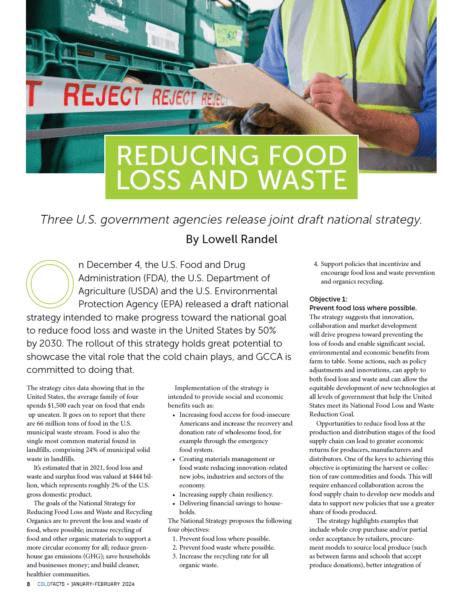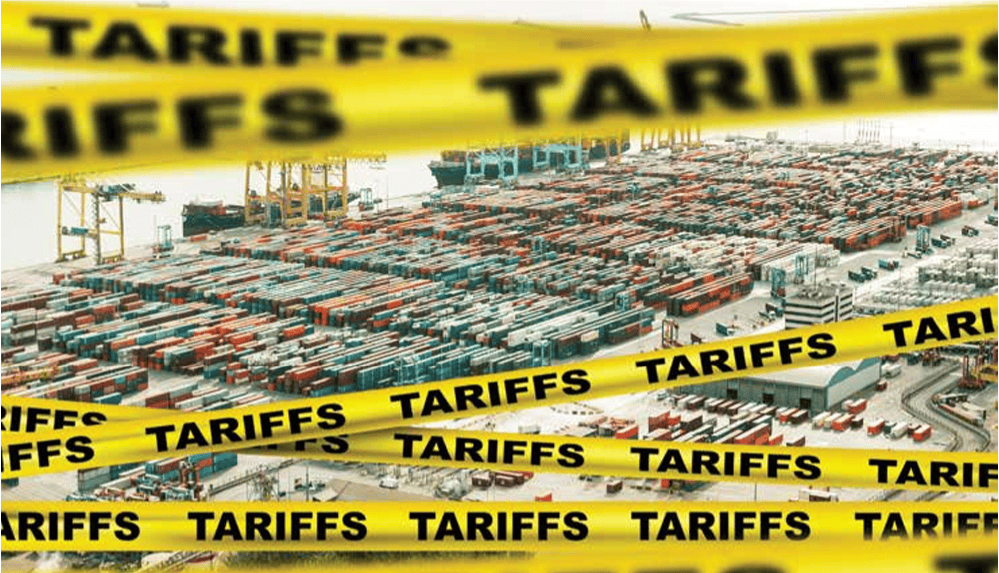From COLD FACTS Magazine (Click Image)
Read Below:
Reducing Food Loss and Waste
Three U.S. government agencies release joint draft national strategy.
By Lowell Randel
On December 4, the U.S. Food and Drug Administration (FDA), the U.S. Department of Agriculture (USDA) and the U.S. Environmental Protection Agency (EPA) released a draft national strategy intended to make progress toward the national goal to reduce food loss and waste in the United States by 50% by 2030. The rollout of this strategy holds great potential to showcase the vital role that the cold chain plays, and GCCA is committed to doing that.
The strategy cites data showing that in the United States, the average family of four spends $1,500 each year on food that ends up uneaten. It goes on to report that there are 66 million tons of food in the U.S. municipal waste stream. Food is also the single most common material found in landfills, comprising 24% of municipal solid waste in landfills.
It’s estimated that in 2021, food loss and waste and surplus food was valued at $444 billion, which represents roughly 2% of the U.S. gross domestic product.
The goals of the National Strategy for Reducing Food Loss and Waste and Recycling Organics are to prevent the loss and waste of food, where possible; increase recycling of food and other organic materials to support a more circular economy for all; reduce green-house gas emissions (GHG); save households and businesses money; and build cleaner, healthier communities.
Implementation of the strategy is intended to provide social and economic benefits such as:
- Increasing food access for food-insecure Americans and increase the recovery and donation rate of wholesome food, for example through the emergency
- food system.
- Creating materials management or food waste reducing innovation-related new jobs, industries and sectors of the economy.
- Increasing supply chain resiliency.
- Delivering financial savings to households.
The National Strategy proposes the following four objectives:
- Prevent food loss where possible.
- Prevent food waste where possible.
- Increase the recycling rate for all organic waste
- Support policies that incentivize and encourage food loss and waste prevention and organics recycling.
Objective 1:
Prevent food loss where possible.
The strategy suggests that innovation, collaboration and market development
will drive progress toward preventing the loss of foods and enable significant social, environmental and economic benefits from farm to table. Some actions, such as policy adjustments and innovations, can apply to both food loss and waste and can allow the equitable development of new technologies at all levels of government that help the United States meet its National Food Loss and Waste Reduction Goal.
Opportunities to reduce food loss at the production and distribution stages of the food supply chain can lead to greater economic returns for producers, manufacturers and distributors. One of the keys to achieving this objective is optimizing the harvest or collection of raw commodities and foods. This will require enhanced collaboration across the food supply chain to develop new models and data to support new policies that use a greater share of foods produced.
The strategy highlights examples that include whole crop purchase and/or partial order acceptance by retailers, procure-ment models to source local produce (such as between farms and schools that accept produce donations), better integration of production and processing facilities, improved on-farm storage, and technical assistance on loss reduction approaches through public-private partnerships.
The strategy identifies the need for technological innovations, such as improvements in demand forecasting, leveraging predictive analytics (i.e., artificial intelligence), strengthening on-farm food rescue and the equitable distribution of surplus food. The strategy also calls out the need to optimize handling, routing and storage; improve transportation, inventory and supply chain management with best practices and technologies, such as artificial intelligence, blockchain technology and remote sensing.
GCCA is already actively working with food banks and is well positioned to play a role in advancing this objective.
Objective 2:
Prevent the waste of food where possible.
Food waste from consumers and consumer-facing businesses (retail and food service) comprises roughly half of U.S. food loss and waste. This carries larger environmental and economic costs than food losses upstream (i.e., on-farm or within food processing and distribution), since costs accumulate as food is wasted further down the supply chain.
Suggested actions to achieve Objective 2 include:
- Developing a national consumer education and behavior-change campaign.
- Educating children and youth about strategies to reduce food waste and encouraging adoption of lifelong best practices in schools to reduce food waste.
- Partnering with the private sector to find upstream solutions to consumer food waste.
- Facilitating and incentivizing food donations to improve access to healthy and affordable food.
- Identifying and addressing drivers of U.S. food loss and waste and the incentives to reduce it.
- Investing in behavioral science to determine the most effective strategies to change household behaviors related to food waste.
- Identifying technology-based solutions and best practices to reduce food loss and waste among retailers, manufacturers and food service providers, including in their supply chains.
Objective 3:
Increase the recycling rate for all organic waste.
Recycling organic waste offers the opportunity to recover valuable resources, such
as nutrients and energy, and create healthy soils. Certain types of organic waste can be converted to animal food, composted, anaerobically digested, or converted into energy or other products, thus providing nutrients to livestock, returning nutrients to the soil, or displacing the use of fossil fuels—all while reducing GHGs. Organics recycling can help build a more circular economy and reduce landfill methane emissions.
Objective 4:
Support policies that incentivize and encourage food loss and waste prevention and organics recycling.
The strategy calls for the development of policies that incentivize and encourage the prevention of food loss and waste, redistribution
of surplus food, development of additional organics recycling infrastructure, and expansion of markets for recycled products made from organics and soil amendments made from food and other organic waste to help the United States meet its food loss and waste reduction goals. These policies can be federal, state and local, and many states and cities have already enacted policies to reduce food waste.
GCCA is encouraged by the release of
the draft national strategy and will continue working closely with USDA, FDA and EPA as the agencies work towards implementation. GCCA will also build on its collaboration with food industry partners, food banks and others in the private sector to advance our shared goal of reducing food loss and waste.




